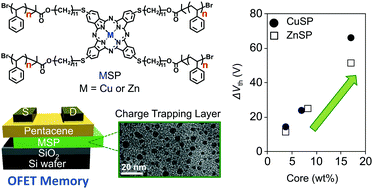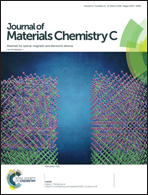A star polymer with a metallo-phthalocyanine core as a tunable charge storage material for nonvolatile transistor memory devices†
Abstract
We present a strategy for controlling the device performance of organic field effect transistor (OFET) memory devices by using a metallo-phthalocyanine (MPc)-cored star-shaped polystyrene as a charge storage material. MPc-cored four-armed star polymers (M = Cu or Zn) with polystyrene arms of three different number-average molecular weights were prepared by atom transfer radical polymerization and cyclization reactions with metal ions; the density of the MPc cores dispersed in the polymer matrix was dependent on the lengths of polymer arms. The charge carrier mobility of pentacene-based OFET memory devices containing the star polymer varied with the nature of the MPc-cored star polymer layer owing to the presence of the MPc core unit as well as the nanostructures of the polymer thin films. Application of an external gate bias to the OFET device caused significant reversible shifts in the threshold voltage, and the magnitude of the memory shifts was proportional to the weight percentage of MPc cores in the star polymer matrix. The memory device showed a high memory on/off current ratio (>105) and long retention characteristics (>105 s), permitting it to be characterized as a nonvolatile organic memory device; the retention time extended upon increasing the Mn of the star polymer. The MPc-cored star polymer is a promising material designed as a charge storage layer for controlling the performance of organic flash memory devices.



 Please wait while we load your content...
Please wait while we load your content...